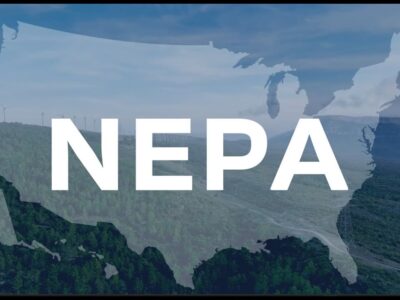NEPA and Loper Deference (Part II)
Legal Planet: Environmental Law and Policy 2024-12-03

Dan provided a terrific overview of the legal issues involved in the D.C. Circuit’s recent decision holding that CEQ lacks authority to promulgate regulations and, therefore, that the regulations governing implementation of NEPA across the government for decades are ultra vires. I want to offer some additional observations focused on the potential practical implications.
First, I agree with Dan’s assessment that regardless of whether the CEQ regulations bind other federal agencies, they could (and should) continue to provide important guidance to the agencies and the courts. That potential may, however, diminish considerably in the coming weeks. The validity of CEQ’s 2024 NEPA regulations are before the District of North Dakota in a lawsuit brought by a cadre of Republican Attorneys General. At a hearing on November 20, the judge appeared inclined to follow the D.C. Circuit’s lead and vacate the regulations in their entirety on the theory that CEQ lacks authority to issue them.
Second, significant interagency coordination problems will arise if CEQ’s regulations don’t provide a standardized approach to NEPA implementation for the 15 federal departments and dozens of other agencies with NEPA responsibilities.
Many activities involve multiple agencies, and that’s true for activities with support across the political spectrum. The Mountain Valley Pipeline carrying natural gas from West Virginia to Virginia required approvals from the Army Corps of Engineers, Bureau of Land Management, National Park Service, and the Forest Service. The Empire Wind project supplying renewable energy to New York City required approvals from the Army Corps of Engineers, NOAA Fisheries, and the Bureau of Ocean Energy Management.
On projects like those, and many more, agencies currently work together in a single environmental review process overseen by a “lead agency” that results in one environmental impact statement (EIS) that each agency can rely on in making its decision. This unified process avoids duplication of effort, inconsistent analysis (and a concomitant risk of successful litigation), and public confusion. It also promotes accountability and gives project sponsors a single agency with whom to communicate about environmental reviews.
The conditions for efficient unified environmental reviews depend on a common set of NEPA procedures. The CEQ regulations serve that purpose. They result in a NEPA framework that is more centralized, cohesive, and consistent, even if imperfectly so. In their absence, each agency will need to develop their own procedures, which will almost certainly lead to less consistency and more complicated and costly environmental reviews.
Third, decentralizing NEPA implementation is squarely at odds with the bipartisan consensus on how to improve federal permitting. In 2015, Congress enacted FAST-41 to require federal agencies to more closely coordinate on EISs (and permitting more generally) for large projects in certain priority categories. The 2023 Bipartisan Infrastructure Law went a step further and required agencies involved in federal highway projects to issue a joint EIS and one federal decision covering all of the relevant agency actions.
Those permitting reforms reflect Congress’s judgment that efficient environmental review requires integration, not decentralization. That same judgment is reflected in the 2023 NEPA amendments, which codified provisions of the CEQ regulations requiring designation of a lead agency for projects involving multiple agencies, and directing CEQ to identify a lead agency if the agencies involved cannot agree.
The first Trump Administration also believed that the CEQ regulations served an important function to centralize and harmonize the environmental review process, even if it took a different view of what that process should entail. Indeed, the 2020 CEQ regulations specifically provided that they overrode any inconsistent NEPA procedures adopted by the agencies. The Biden Administration dropped that provision in favor of a process through which agencies and CEQ work together to maintain consistent environmental review procedures.
I could find hope that a second Trump Administration will mount a sustained defense of CEQ’s authority, since the first Trump Administration leaned into CEQ’s authority to bind other agencies more than any other administration has done. I hope that’s true. The glee I hear over the unravelling of CEQ’s authority suggests otherwise.
Guest contributor Justin Pidot holds the Ashby Lohse Chair in Water & Natural Resources at the University of Arizona James E. Rogers College of Law, where he co-directs the Environmental Law, Science and Policy Program.